Business Decision Making: Investment Evaluation with NPV & Payback
VerifiedAdded on 2023/06/14
|7
|1363
|196
Report
AI Summary
This report delves into business decision-making, focusing on investment evaluation using the Net Present Value (NPV) and payback period methods within a UK food manufacturing context. It calculates the NPV for both dairy and non-dairy milk projects, highlighting Project B as the more profitable option based on NPV analysis, while Project A demonstrates a shorter payback period. The report further discusses the significance of financial factors like liquidity, ROI, financial statements, and interest rates, alongside non-financial factors such as technology, managerial competency, distribution channels, and political influences, in shaping effective decision-making processes. Ultimately, the study underscores the importance of employing both discounting and non-discounting techniques in capital budgeting to make informed investment choices that align with organizational goals and market dynamics. Desklib offers a wealth of similar resources for students seeking to deepen their understanding of business and finance.

BUSINESS DECISION
MAKING
MAKING
Paraphrase This Document
Need a fresh take? Get an instant paraphrase of this document with our AI Paraphraser
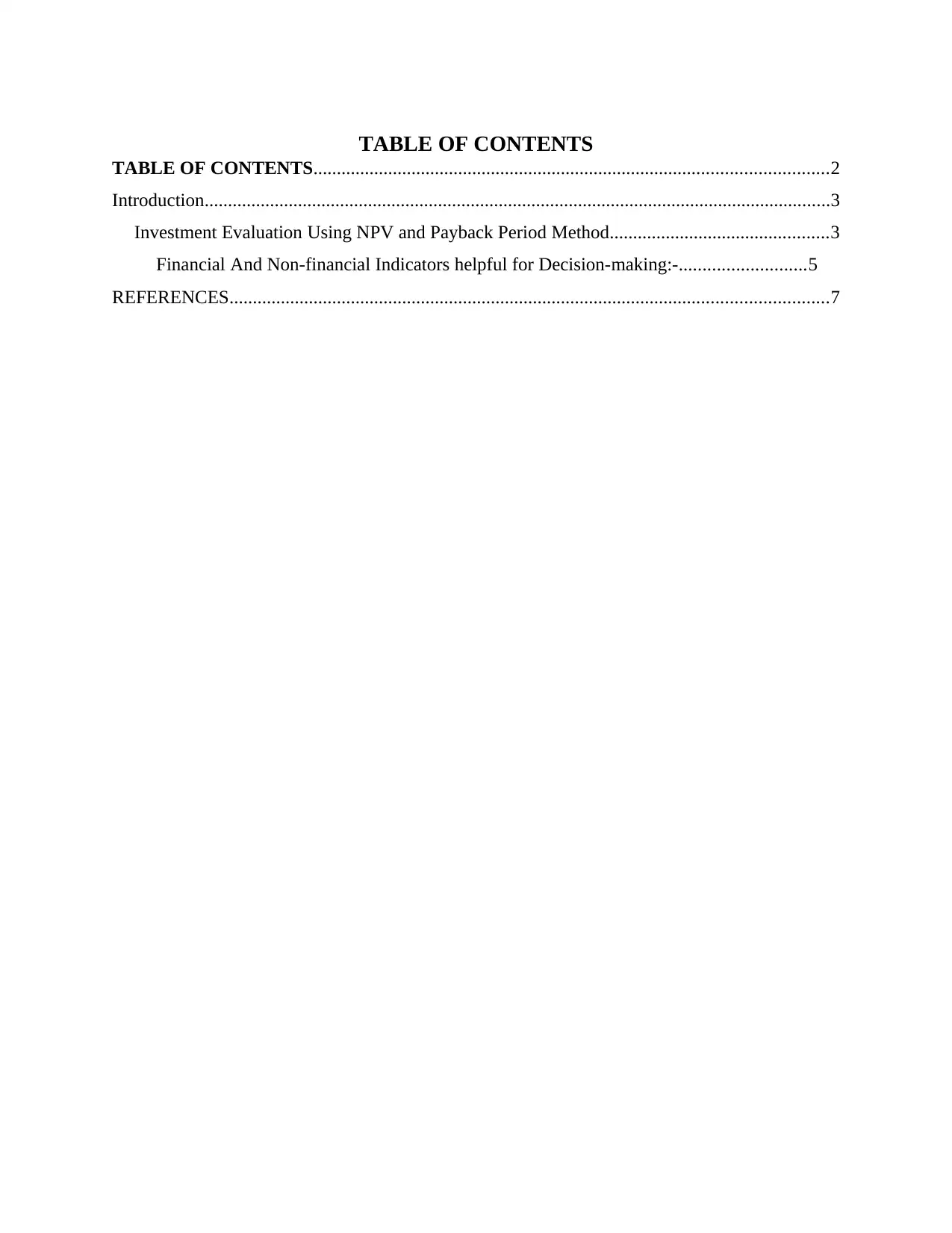
TABLE OF CONTENTS
TABLE OF CONTENTS..............................................................................................................2
Introduction......................................................................................................................................3
Investment Evaluation Using NPV and Payback Period Method...............................................3
Financial And Non-financial Indicators helpful for Decision-making:-...........................5
REFERENCES................................................................................................................................7
TABLE OF CONTENTS..............................................................................................................2
Introduction......................................................................................................................................3
Investment Evaluation Using NPV and Payback Period Method...............................................3
Financial And Non-financial Indicators helpful for Decision-making:-...........................5
REFERENCES................................................................................................................................7
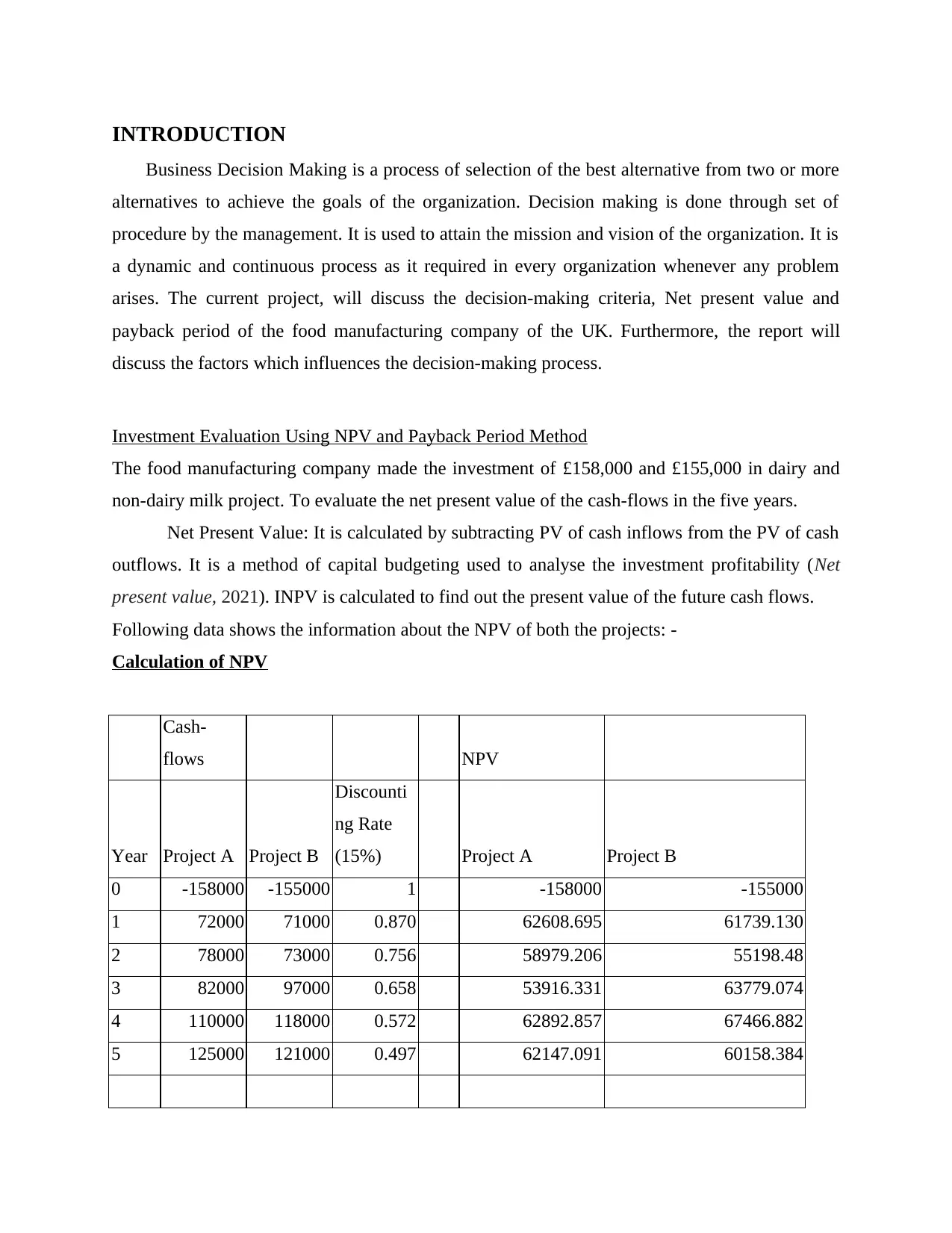
INTRODUCTION
Business Decision Making is a process of selection of the best alternative from two or more
alternatives to achieve the goals of the organization. Decision making is done through set of
procedure by the management. It is used to attain the mission and vision of the organization. It is
a dynamic and continuous process as it required in every organization whenever any problem
arises. The current project, will discuss the decision-making criteria, Net present value and
payback period of the food manufacturing company of the UK. Furthermore, the report will
discuss the factors which influences the decision-making process.
Investment Evaluation Using NPV and Payback Period Method
The food manufacturing company made the investment of £158,000 and £155,000 in dairy and
non-dairy milk project. To evaluate the net present value of the cash-flows in the five years.
Net Present Value: It is calculated by subtracting PV of cash inflows from the PV of cash
outflows. It is a method of capital budgeting used to analyse the investment profitability (Net
present value, 2021). INPV is calculated to find out the present value of the future cash flows.
Following data shows the information about the NPV of both the projects: -
Calculation of NPV
Cash-
flows NPV
Year Project A Project B
Discounti
ng Rate
(15%) Project A Project B
0 -158000 -155000 1 -158000 -155000
1 72000 71000 0.870 62608.695 61739.130
2 78000 73000 0.756 58979.206 55198.48
3 82000 97000 0.658 53916.331 63779.074
4 110000 118000 0.572 62892.857 67466.882
5 125000 121000 0.497 62147.091 60158.384
Business Decision Making is a process of selection of the best alternative from two or more
alternatives to achieve the goals of the organization. Decision making is done through set of
procedure by the management. It is used to attain the mission and vision of the organization. It is
a dynamic and continuous process as it required in every organization whenever any problem
arises. The current project, will discuss the decision-making criteria, Net present value and
payback period of the food manufacturing company of the UK. Furthermore, the report will
discuss the factors which influences the decision-making process.
Investment Evaluation Using NPV and Payback Period Method
The food manufacturing company made the investment of £158,000 and £155,000 in dairy and
non-dairy milk project. To evaluate the net present value of the cash-flows in the five years.
Net Present Value: It is calculated by subtracting PV of cash inflows from the PV of cash
outflows. It is a method of capital budgeting used to analyse the investment profitability (Net
present value, 2021). INPV is calculated to find out the present value of the future cash flows.
Following data shows the information about the NPV of both the projects: -
Calculation of NPV
Cash-
flows NPV
Year Project A Project B
Discounti
ng Rate
(15%) Project A Project B
0 -158000 -155000 1 -158000 -155000
1 72000 71000 0.870 62608.695 61739.130
2 78000 73000 0.756 58979.206 55198.48
3 82000 97000 0.658 53916.331 63779.074
4 110000 118000 0.572 62892.857 67466.882
5 125000 121000 0.497 62147.091 60158.384
⊘ This is a preview!⊘
Do you want full access?
Subscribe today to unlock all pages.

Trusted by 1+ million students worldwide
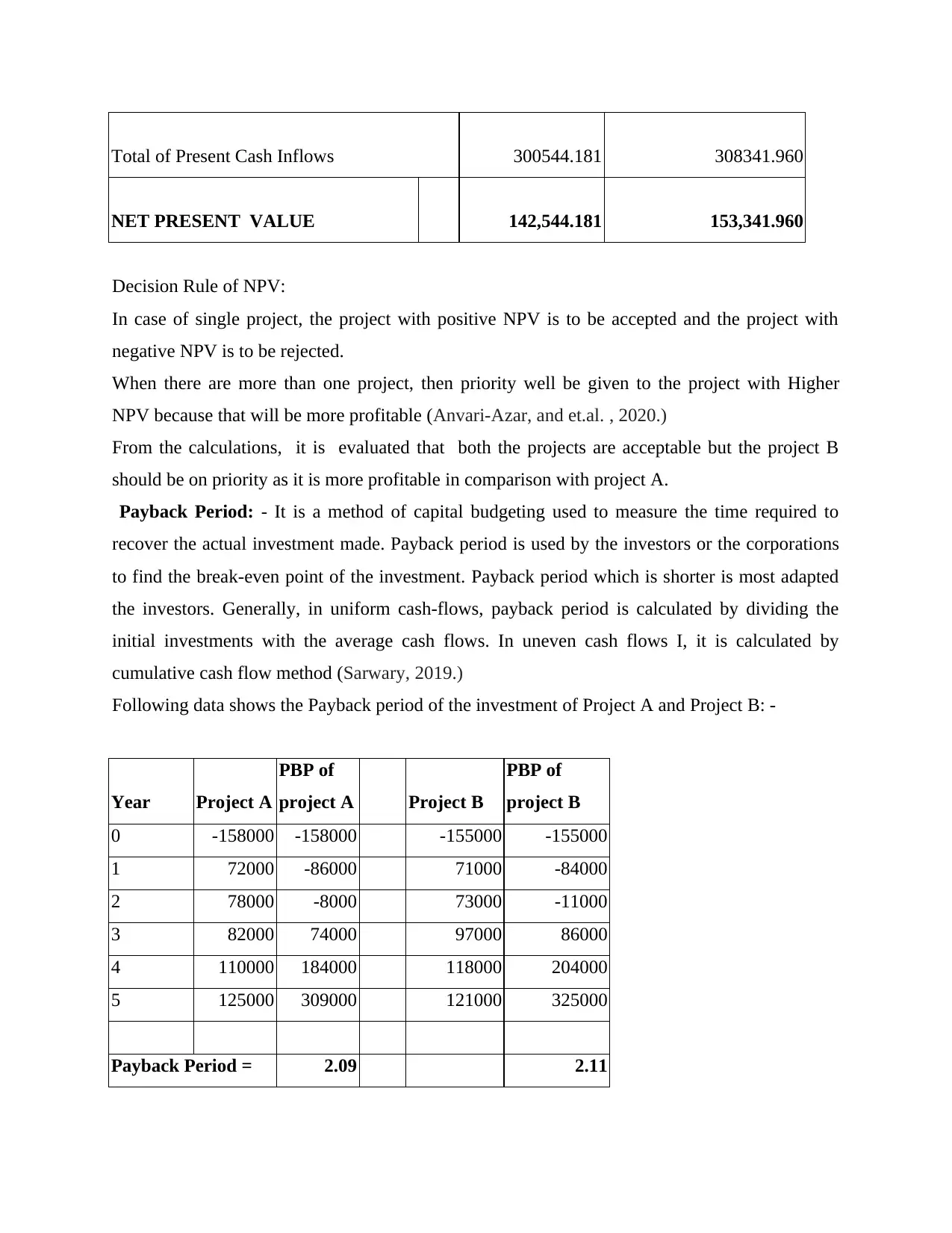
Total of Present Cash Inflows 300544.181 308341.960
NET PRESENT VALUE 142,544.181 153,341.960
Decision Rule of NPV:
In case of single project, the project with positive NPV is to be accepted and the project with
negative NPV is to be rejected.
When there are more than one project, then priority well be given to the project with Higher
NPV because that will be more profitable (Anvari-Azar, and et.al. , 2020.)
From the calculations, it is evaluated that both the projects are acceptable but the project B
should be on priority as it is more profitable in comparison with project A.
Payback Period: - It is a method of capital budgeting used to measure the time required to
recover the actual investment made. Payback period is used by the investors or the corporations
to find the break-even point of the investment. Payback period which is shorter is most adapted
the investors. Generally, in uniform cash-flows, payback period is calculated by dividing the
initial investments with the average cash flows. In uneven cash flows I, it is calculated by
cumulative cash flow method (Sarwary, 2019.)
Following data shows the Payback period of the investment of Project A and Project B: -
Year Project A
PBP of
project A Project B
PBP of
project B
0 -158000 -158000 -155000 -155000
1 72000 -86000 71000 -84000
2 78000 -8000 73000 -11000
3 82000 74000 97000 86000
4 110000 184000 118000 204000
5 125000 309000 121000 325000
Payback Period = 2.09 2.11
NET PRESENT VALUE 142,544.181 153,341.960
Decision Rule of NPV:
In case of single project, the project with positive NPV is to be accepted and the project with
negative NPV is to be rejected.
When there are more than one project, then priority well be given to the project with Higher
NPV because that will be more profitable (Anvari-Azar, and et.al. , 2020.)
From the calculations, it is evaluated that both the projects are acceptable but the project B
should be on priority as it is more profitable in comparison with project A.
Payback Period: - It is a method of capital budgeting used to measure the time required to
recover the actual investment made. Payback period is used by the investors or the corporations
to find the break-even point of the investment. Payback period which is shorter is most adapted
the investors. Generally, in uniform cash-flows, payback period is calculated by dividing the
initial investments with the average cash flows. In uneven cash flows I, it is calculated by
cumulative cash flow method (Sarwary, 2019.)
Following data shows the Payback period of the investment of Project A and Project B: -
Year Project A
PBP of
project A Project B
PBP of
project B
0 -158000 -158000 -155000 -155000
1 72000 -86000 71000 -84000
2 78000 -8000 73000 -11000
3 82000 74000 97000 86000
4 110000 184000 118000 204000
5 125000 309000 121000 325000
Payback Period = 2.09 2.11
Paraphrase This Document
Need a fresh take? Get an instant paraphrase of this document with our AI Paraphraser
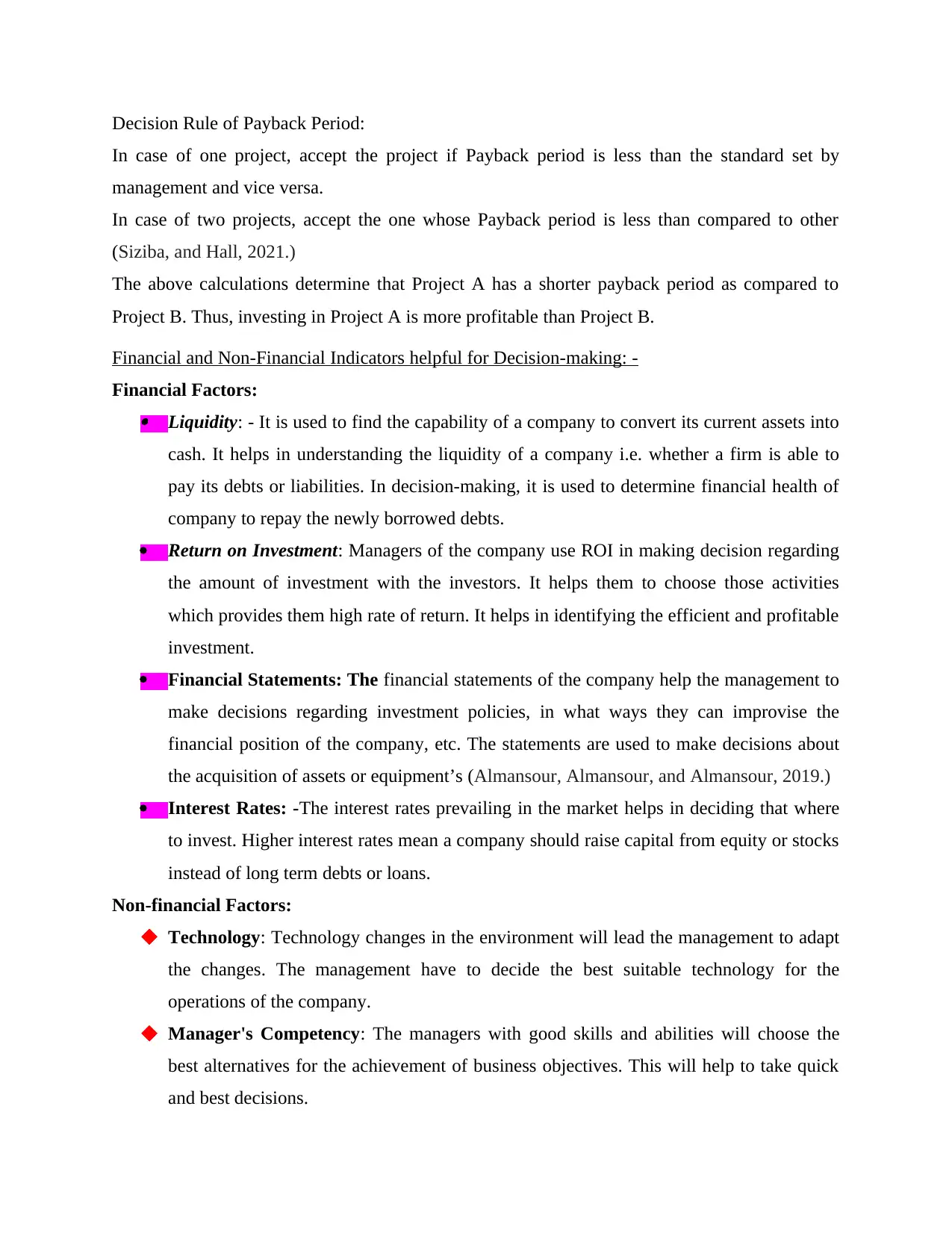
Decision Rule of Payback Period:
In case of one project, accept the project if Payback period is less than the standard set by
management and vice versa.
In case of two projects, accept the one whose Payback period is less than compared to other
(Siziba, and Hall, 2021.)
The above calculations determine that Project A has a shorter payback period as compared to
Project B. Thus, investing in Project A is more profitable than Project B.
Financial and Non-Financial Indicators helpful for Decision-making: -
Financial Factors: Liquidity: - It is used to find the capability of a company to convert its current assets into
cash. It helps in understanding the liquidity of a company i.e. whether a firm is able to
pay its debts or liabilities. In decision-making, it is used to determine financial health of
company to repay the newly borrowed debts.
Return on Investment: Managers of the company use ROI in making decision regarding
the amount of investment with the investors. It helps them to choose those activities
which provides them high rate of return. It helps in identifying the efficient and profitable
investment.
Financial Statements: The financial statements of the company help the management to
make decisions regarding investment policies, in what ways they can improvise the
financial position of the company, etc. The statements are used to make decisions about
the acquisition of assets or equipment’s (Almansour, Almansour, and Almansour, 2019.)
Interest Rates: -The interest rates prevailing in the market helps in deciding that where
to invest. Higher interest rates mean a company should raise capital from equity or stocks
instead of long term debts or loans.
Non-financial Factors:
Technology: Technology changes in the environment will lead the management to adapt
the changes. The management have to decide the best suitable technology for the
operations of the company.
Manager's Competency: The managers with good skills and abilities will choose the
best alternatives for the achievement of business objectives. This will help to take quick
and best decisions.
In case of one project, accept the project if Payback period is less than the standard set by
management and vice versa.
In case of two projects, accept the one whose Payback period is less than compared to other
(Siziba, and Hall, 2021.)
The above calculations determine that Project A has a shorter payback period as compared to
Project B. Thus, investing in Project A is more profitable than Project B.
Financial and Non-Financial Indicators helpful for Decision-making: -
Financial Factors: Liquidity: - It is used to find the capability of a company to convert its current assets into
cash. It helps in understanding the liquidity of a company i.e. whether a firm is able to
pay its debts or liabilities. In decision-making, it is used to determine financial health of
company to repay the newly borrowed debts.
Return on Investment: Managers of the company use ROI in making decision regarding
the amount of investment with the investors. It helps them to choose those activities
which provides them high rate of return. It helps in identifying the efficient and profitable
investment.
Financial Statements: The financial statements of the company help the management to
make decisions regarding investment policies, in what ways they can improvise the
financial position of the company, etc. The statements are used to make decisions about
the acquisition of assets or equipment’s (Almansour, Almansour, and Almansour, 2019.)
Interest Rates: -The interest rates prevailing in the market helps in deciding that where
to invest. Higher interest rates mean a company should raise capital from equity or stocks
instead of long term debts or loans.
Non-financial Factors:
Technology: Technology changes in the environment will lead the management to adapt
the changes. The management have to decide the best suitable technology for the
operations of the company.
Manager's Competency: The managers with good skills and abilities will choose the
best alternatives for the achievement of business objectives. This will help to take quick
and best decisions.
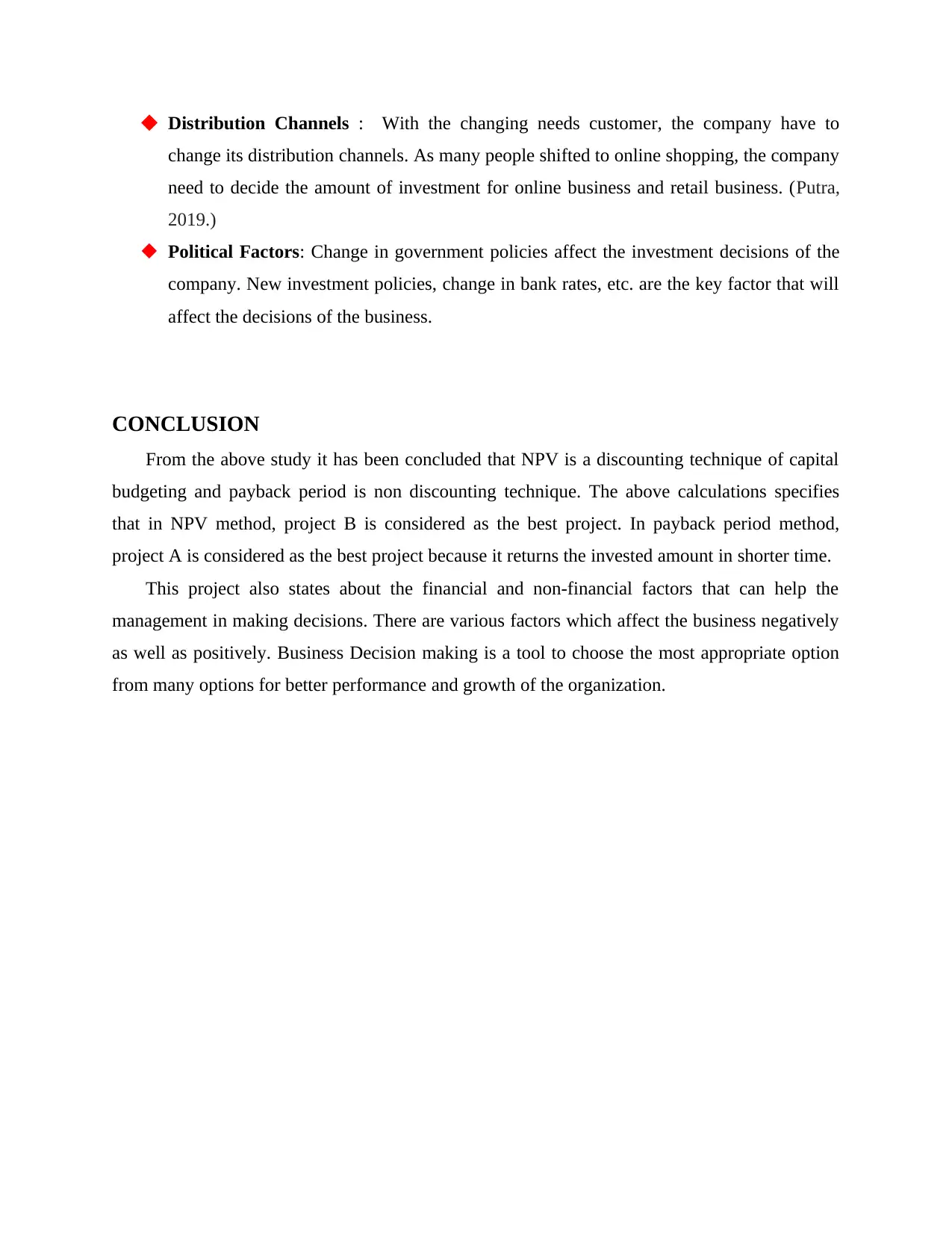
Distribution Channels : With the changing needs customer, the company have to
change its distribution channels. As many people shifted to online shopping, the company
need to decide the amount of investment for online business and retail business. (Putra,
2019.)
Political Factors: Change in government policies affect the investment decisions of the
company. New investment policies, change in bank rates, etc. are the key factor that will
affect the decisions of the business.
CONCLUSION
From the above study it has been concluded that NPV is a discounting technique of capital
budgeting and payback period is non discounting technique. The above calculations specifies
that in NPV method, project B is considered as the best project. In payback period method,
project A is considered as the best project because it returns the invested amount in shorter time.
This project also states about the financial and non-financial factors that can help the
management in making decisions. There are various factors which affect the business negatively
as well as positively. Business Decision making is a tool to choose the most appropriate option
from many options for better performance and growth of the organization.
change its distribution channels. As many people shifted to online shopping, the company
need to decide the amount of investment for online business and retail business. (Putra,
2019.)
Political Factors: Change in government policies affect the investment decisions of the
company. New investment policies, change in bank rates, etc. are the key factor that will
affect the decisions of the business.
CONCLUSION
From the above study it has been concluded that NPV is a discounting technique of capital
budgeting and payback period is non discounting technique. The above calculations specifies
that in NPV method, project B is considered as the best project. In payback period method,
project A is considered as the best project because it returns the invested amount in shorter time.
This project also states about the financial and non-financial factors that can help the
management in making decisions. There are various factors which affect the business negatively
as well as positively. Business Decision making is a tool to choose the most appropriate option
from many options for better performance and growth of the organization.
⊘ This is a preview!⊘
Do you want full access?
Subscribe today to unlock all pages.

Trusted by 1+ million students worldwide
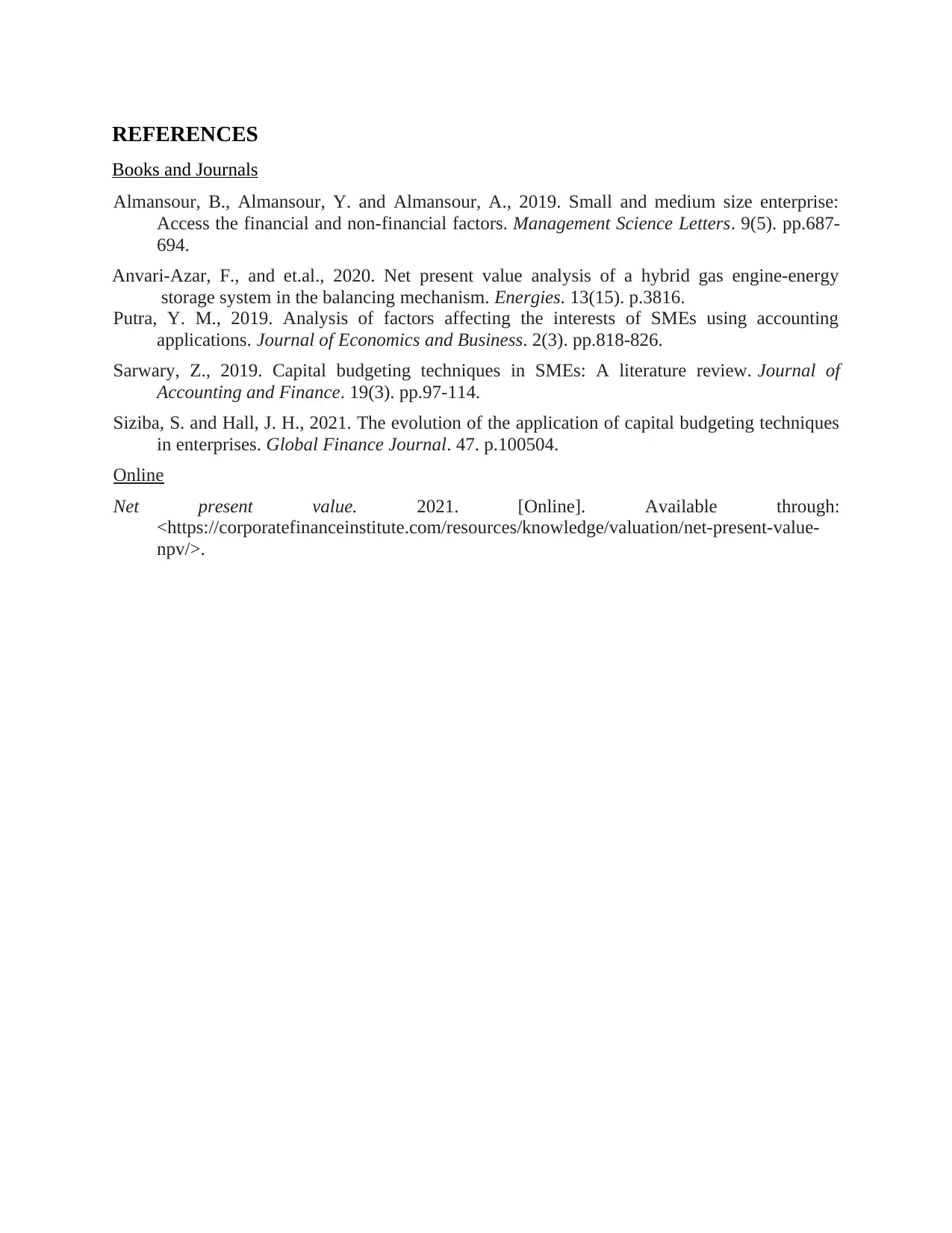
REFERENCES
Books and Journals
Almansour, B., Almansour, Y. and Almansour, A., 2019. Small and medium size enterprise:
Access the financial and non-financial factors. Management Science Letters. 9(5). pp.687-
694.
Anvari-Azar, F., and et.al., 2020. Net present value analysis of a hybrid gas engine-energy
storage system in the balancing mechanism. Energies. 13(15). p.3816.
Putra, Y. M., 2019. Analysis of factors affecting the interests of SMEs using accounting
applications. Journal of Economics and Business. 2(3). pp.818-826.
Sarwary, Z., 2019. Capital budgeting techniques in SMEs: A literature review. Journal of
Accounting and Finance. 19(3). pp.97-114.
Siziba, S. and Hall, J. H., 2021. The evolution of the application of capital budgeting techniques
in enterprises. Global Finance Journal. 47. p.100504.
Online
Net present value. 2021. [Online]. Available through:
<https://corporatefinanceinstitute.com/resources/knowledge/valuation/net-present-value-
npv/>.
Books and Journals
Almansour, B., Almansour, Y. and Almansour, A., 2019. Small and medium size enterprise:
Access the financial and non-financial factors. Management Science Letters. 9(5). pp.687-
694.
Anvari-Azar, F., and et.al., 2020. Net present value analysis of a hybrid gas engine-energy
storage system in the balancing mechanism. Energies. 13(15). p.3816.
Putra, Y. M., 2019. Analysis of factors affecting the interests of SMEs using accounting
applications. Journal of Economics and Business. 2(3). pp.818-826.
Sarwary, Z., 2019. Capital budgeting techniques in SMEs: A literature review. Journal of
Accounting and Finance. 19(3). pp.97-114.
Siziba, S. and Hall, J. H., 2021. The evolution of the application of capital budgeting techniques
in enterprises. Global Finance Journal. 47. p.100504.
Online
Net present value. 2021. [Online]. Available through:
<https://corporatefinanceinstitute.com/resources/knowledge/valuation/net-present-value-
npv/>.
1 out of 7
Related Documents
Your All-in-One AI-Powered Toolkit for Academic Success.
+13062052269
info@desklib.com
Available 24*7 on WhatsApp / Email
![[object Object]](/_next/static/media/star-bottom.7253800d.svg)
Unlock your academic potential
Copyright © 2020–2025 A2Z Services. All Rights Reserved. Developed and managed by ZUCOL.


